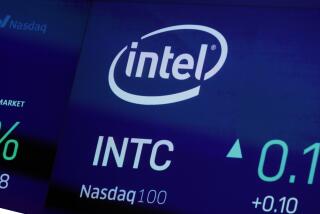Silicon Graphics to Cut Up to 1,500 Jobs
- Share via
SAN FRANCISCO — Silicon Graphics Inc., a struggling pioneer in sophisticated computer graphics and special effects, Tuesday announced a major restructuring that will result in the loss of up to 1,500 jobs, or 17% of its work force.
The company also said it will turn its storied Cray supercomputer unit into a separate company and attempt to sell it. SGI was never able to grow Cray, which was acquired for $576 million in 1996.
SGI will also spin off its division that produces computer workstations based on Microsoft’s Windows NT operating system. Executives declined to name the partner that will soon acquire what may be a majority share of that business.
The Cray and NT division moves could affect another 1,000 to 1,500 jobs beyond the announced layoffs, said John R. Vrolyk, senior vice president.
The actions focus SGI’s strategy on producing machines using the Linux operating system, a free, upstart competitor to Microsoft Corp.’s Windows NT and Sun Microsystems Inc.’s Solaris that has become a leading tool for server computers that run Internet sites and business networks.
Wall Street reacted negatively to the announcements. Shares of Mountain View, Calif.-based SGI lost $3.75 to close at $12.44 on the New York Stock Exchange, a drop of nearly a quarter of its value.
“They are finally taking some of the bitter pills that they should have taken 18 months ago,” said John B. Jones Jr., an analyst with Salomon Smith Barney in San Francisco. “The problem, and the reason why the stock is acting the way it is: It’s another 18-month transition.”
Vrolyk acknowledged that beneficial results of the changes may not be apparent for six to 12 months.
Historically, SGI has built the best computers and software for complex and realistic visual effects. Its systems--using the company’s proprietary IRIX operating system and special microprocessors tailored for 3-D visualization--were used for such groundbreaking films as “Jurassic Park” and “Toy Story.” But the top SGI machines cost tens of thousands of dollars.
As less expensive workstations have rapidly become more powerful in recent years, the advantages of SGI’s systems have eroded--as has its cadre of software developers. Traditional competitors such as Sun and IBM Corp. took advantage of the weakness, as did Compaq Computer Corp. and Dell Computer Corp.
In response, SGI began to replace its own microprocessors with less costly alternatives made by Intel Corp. and to use Windows NT for its lower-end machines.
But the company still saw its share of workstation market revenue plummet from 10.3% in the first quarter of 1998 to 8.5% in the same period this year, said an analyst from San Jose-based DataQuest. SGI experienced a similar slide in its revenue for servers, according to Framingham, Mass.-based International Data Corp.
“The challenge has historically been that SGI’s infrastructure, their knowledge, their focus, their customer contacts are all on the high-performance sides of the world, not in the commercial side where Sun, [Hewlett-Packard Co.] and others play,” Jones said.
Yet the commercial market is surging due to the Internet.
SGI hopes an emphasis on Linux will make its powerful hardware more flexible and appealing for a wide range of workstations and servers--particularly for moving film clips and other streaming media over high-speed networks and for collaborations between high-performance workstations and servers.
“Our problem has been that we just don’t have the applications breadth,” Vrolyk said. “Linux has an adoption rate in the marketplace of 1 million new users a month,” suggesting that a wide range of software programs will follow that burgeoning market.
Analysts agreed that the move to Linux makes sense.
“SGI can say, ‘Of all the system vendors we have the cleanest shot of becoming a pure Linux play,’ ” said Daniel Kunstler, an analyst with investment banker J.P. Morgan in San Francisco. That would be an enticing strategy if Linux emerges as the top alternative to Microsoft.
While the Windows NT market already is saturated with competitors, “Linux is the unfortified hill” waiting to be captured, Jones said. “The Linux market will be the next really high-growth market sector,” he added, “because the big Fortune 500 companies don’t like having only one alternative”--namely, Microsoft.
SGI’s moves follow a streamlining process that helped it achieve its first profitable quarter in two years, announced July 21, and have prompted speculation that the company will put itself up for sale soon. Rumors that IBM could be interested led to a run-up of its stock early this year.
Cray, in particular, had to be jettisoned under such a scenario, Kunstler said. “They have to have the leanest operating expense base that they possibly can.”




